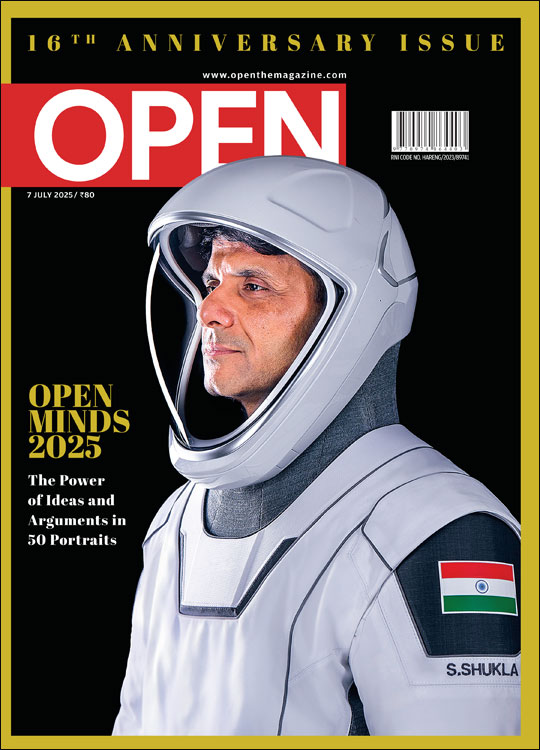The Curious Case of an Indian Arab Cricketer
A once-promising but long-forgotten name in Mumbai’s domestic circuit turns up at the World Cup for another country. The story of Swapnil Patil
 Lhendup G Bhutia
Lhendup G Bhutia
 Lhendup G Bhutia
Lhendup G Bhutia
 |
12 Mar, 2015
|
12 Mar, 2015
/wp-content/uploads/2016/01/18028.thecuriouscase1.jpg)
The cricket team of the United Arab Emirates (UAE) is the flotsam and jetsam of international cricket. Its players are mostly rejects of their native countries’ cricket selectors. They played cricket once. But they gave up the sport and the dreams it once promised them to take up jobs in this oil-rich Gulf country. Now, they are playing the sport once again, and that too, at cricket’s marquee tournament: the ICC World Cup.
Among members of this UAE team of Emiratis (just two of them), Pakistani and Sri Lankan salesmen, flight attendants and bankers who moonlight as cricketers, is a receptionist at a construction company from India who was given a promotion as sales executive when he was selected to play for the UAE. Swapnil Patil, who along with the Kerala-born Krishnachandran Karate are the two Indian players playing for the Middle Eastern country, was once considered a promising cricketer and a certainty for Mumbai’s Ranji Trophy team. Patil did all the right things, got scholarships from top cricket academies like Vengsarkar Cricket Academy, played all the right tournaments, moving up the ranks from the Under-14 to the Under-22 levels. But he never made it to the next level.
As his father, Prakash Patil, explains, “Life got in the way.”
Darpale Gaon in Vasai is the back of Mumbai’s beyond. It is located 25 railway stations away from Churchgate in Mumbai on a slow local train. Several years ago, a young boy would board, almost on a daily basis, a local train packed to the brim with the city’s vegetable and flower sellers at five in the morning, carrying with him an exceptionally heavy bag containing a batsman-and-wicketkeeper’s kit. Patil, the son of a failed cricketer and the younger brother of another cricketer whose dream too was fast coming undone, would travel from this distant suburb in Mumbai to the maidans and cricket academies of the city, determined to make a name for himself in cricket.
He was a contemporary of the current Indian cricket batting stars from Mumbai, Rohit Sharma and Ajinkya Rahane, with the latter and him developing a close friendship as they played together for Mulund Gymkhana in various junior divisions. “Back then,” Vinit Indulkar, a batsman from the Mumbai Ranji team who played against Patil in several junior division matches, says, “nobody knew Ajinkya, but everybody knew Swapnil. He was what we called a khadoos (stubborn) batsman. If we got him out, we knew we had the game in our hands.”
Patil’s father Prakash was a left-arm spinner who played in the city’s various junior divisions. He claims he almost made it into the Ranji side for Vidarbha, but was eventually turned away because of a rule then that he had to be a resident of the area for at least five years. Prakash instead found a clerical job at Bank of Maharashtra, and began to satiate his passion for the game by coaching local cricketers on the side. His eldest son, Rohan Patil, played cricket in junior leagues and for his college, but when he realised he was incapable of pursuing the sport further, he quit cricket to start a general provisions store in the neighbourhood that sells everything from stationery to groceries. The focus of Prakash’s ambitions then solely shifted to Swapnil. So he took voluntary retirement from his bank job, began coaching local cricketers full-time, and began paying attention to honing Swapnil’s talent. Once the task of balancing studies and cricket— especially the long tiresome train journeys—turned a little too tedious, Swapnil suggested quitting his education after class 10, and Prakash agreed.
When Swapnil was around 14 years old, the well-known Mumbai local coach, selector and administrator Vilas Godbole was in Vasai for a Mumbai Cricket Association-approved talent-spotting exercise. Some years before, Godbole, had been one of the Mumbai selectors who had selected Sachin Tendulkar and Vinod Kambli to play for Mumbai after watching their skills in school-level and junior tournaments. Godbole claims there were around 100 young cricketers that day in the ground. But he couldn’t get his eyes off Swapnil. “I’m not comparing him to Tendulkar or Kambli. But back then, he had that raw skill that you saw in a few gifted cricketers like Tendulkar and Kambli. You could call this a coach- selector’s prescience or eye. But you could see that skill in him, which when coupled with effort and guidance, and some luck, makes a cricketer a genius,” Godbole says. “The way Swapnil pulled and hooked the ball, and maintained his balance while playing shots… you could see that he had the makings of a terrific batsman. His technique as a wicketkeeper was exceptional for that age too.” Godbole took the 14-year-old wicketkeeper-batsman under his wing, signed him up for his United Cricketers club, and got him to play in the Kanga League. Patil’s friend and neighbour Devendra Mayekar, who also played as a wicketkeeper-batsman in junior league matches, says, “We all looked up to Swapnil. We all thought he would achieve a lot in cricket.”
But, as the joke goes, it was once considered tougher to get into the Mumbai squad than the Indian team. He made it thrice— in 2001, 2004 and 2005—to the probables list of the Mumbai squad, but never into the final squad. Vinayak Samant, the gritty wicketkeeper-batsman who got his opportunity to keep wickets for the Mumbai team only at the age of 30 after the former Indian and Mumbai player Sameer Dighe relinquished his spot, was then the team’s first choice wicketkeeper. Samant held on to the spot for eight continuous seasons, denying younger wicketkeepers like Swapnil any chance.
“When I look back at my son’s career, I feel he should have played at least at the Ranji level,” Prakash says. “He came so very close.” In 2006, when Patil was around 21 years old, he received an offer to become a player-employee for a construction company based in the UAE. “Swapnil was frustrated. He hadn’t been able to get into the Mumbai team. He had little education. He would probably not have got a job here. And here came this job with a good salary, which also required him to play cricket. We couldn’t not take it,” Prakash says.
Patil moved to Dubai for a new life and career. His friend and contemporary Rahane who had also remained a probable in the Mumbai Ranji side stayed put in the country. The following year, Rahane made his debut for Mumbai. In the next few years, Rahane went on to score several centuries in domestic cricket before making his India debut in 2011.
Emirates, the national carrier of UAE, is everywhere at this Cricket World Cup. As one of the tournament’s major sponsors and its official airline partner, it is on banners beyond the boundary line. It is on LED sideboards. It is on the stumps. It is even on the umpires’ shirts. It is everywhere except on the jersey of UAE’s team. Even with three of their employees playing in the team.
But can you blame the airline for not supporting its national team? The ICC’s headquarters are in Dubai. Pakistan uses it as their base country for cricket. International matches are played here quite regularly. Even the 2014 IPL was held here. But no international team ever plays the country. Before the World Cup began, the UAE team last played a full ICC member seven years ago. The last and only time they were at a World Cup was in 1996.
After Patil moved to Dubai, he began performing well in the local matches. He began to train harder. He worked during the day and trained at night. According to his father, he would report to work at 8:30 am. After he got off at 5 pm, he would head straight for cricket training where he practised till 10 at night. “He did this routine, six days a week, seven years on the trot and counting. During his days off from work, Fridays, he usually plays cricket for his company,” Prakash says.
Four years after he started playing in the UAE, the mandatory period for any cricketer specified by the ICC to be considered for the next level, Swapnil finally made his first class debut. But it was for UAE against Bermuda in 2010. Four years later, during his ODI debut against Scotland in the final of the World Cup qualifiers, he came very close to scoring a century on debut. He needed two runs for a century off the last two balls. He was dropped off the penultimate ball. And the last ball, he edged to midwicket for a single, stranded at 99 not out. Patil went on to become the team’s second-highest scorer at that tournament.
When it became clear that Swapnil was going to be playing for UAE at the World Cup, he flew down to Mumbai last November. He sought out his old coach, Godbole, who arranged a batting session at an indoor facility in the distant Mumbai suburb of Mira Road. “He wanted me to have a look at him and see if any batting and wicket-keeping flaws might have crept into his game over the years,” Godbole recalls.
Swapnil had also been engaged for over five months to a woman his parents had found for him in Mumbai. Wanting his mind free of all possible preoccupations, Prakash arranged a hasty marriage for the two in December. The two travelled to Goa for a short honeymoon. A few days after his return from Goa, Swapnil was on his return flight to Dubai, his newly-married wife left back in his village in Vasai, his mind on the World Cup preparations ahead.
“Life takes strange turns,” Indulkar says. “And it doesn’t come stranger than Swapnil’s life. A once-talented but forgotten player turns up at a World Cup in another country’s colours.” The UAE team is rather unfancied. They’ve had two close games, against minnows Ireland and Zimbabwe (both of which they lost), but were beaten badly by Pakistan and India. Their batsmen fall over when they miss sweep shots. They miss swinging balls by large gaps. Most batsmen are almost always late on their shots, as though they never knew a ball could travel that fast. Their bowling is slow and insipid. And their fielders dive but miss routine collections. They are a bunch of enthusiastic players, but woefully out of the league of their illustrious opponents.
But how do you fault a team which has rarely ever been given the opportunity to play international cricket? The majority of the team is composed of individuals who were once cricketers but who had to submit their ambitions to the necessities of life. And now they have been thrown into an intense competition, stark naked and cruelly alone in front of everyone at a World Cup, against the biggest names in the business.
Swapnil himself hasn’t done much. He has taken a few catches and scored a few 30s. “When I watch him play at the World Cup, and look at the career of his friend Rahane, I think Swapnil too could have achieved so much more. Or perhaps he would have failed miserably. But that’s the risk you have with cricket,” Godbole says. “He misses balls I thought he would easily hit out of the park back then. But he’s playing at the highest level. And he has spent his most important years playing cricket in the UAE where the intensity will be less.”
Nobody knows what will happen next. Swapnil nor any of his teammates will play in the next edition, since the ICC has decided to reduce the next Cup to only ten teams. “He will continue with his job and play cricket on the side, I think,” Mayekar says. “And unfortunately, as age catches up, he will fade as a cricketer… until a point where he will have to quit.”
When Swapnil played for the UAE at the 2014 World Cup in Bangladesh, a tournament where the UAE team was unable to progress beyond the group stage into the Super 10, his family set up a large screen and a projector in a neighbourhood ground, for neighbours and friends to watch the match. This time, the screen and projector have moved into the house—since the games are being played earlier.
After one such game, against Pakistan where Swapnil scored only 36, Prakash says he is far from disappointed in his son. “When he left India, we thought his cricket career was over too,” he says, “And here he is now on our TV sets.”

/wp-content/uploads/2025/06/Cover-OpenMinds2025.jpg)











More Columns
Puri Marks Sixth Major Stampede of The Year Open
Under the sunlit skies, in the city of Copernicus Sabin Iqbal
EC uploads Bihar’s 2003 electoral roll to ease document submission Open